Overview
Because safety is our top priority, the National Highway Traffic Safety Administration and the Department of Transportation want to make sure you have the tools to avoid being in vehicle crashes. TireWise is your resource to help you make smart decisions to keep you and your family safe, whether you’re in the market to buy new tires or want to extend the life and safety of the ones on your car or truck.
Being TireWise
Being TireWise is essential to safe driving. The only thing between you and the road are your tires. TireWise provides drivers with information about buying tires, tire maintenance and labeling, aging, fuel efficiency, and tire retailers. TireWise is also a resource for tire manufacturers, sellers and other partners to provide essential information to consumers for choosing and caring for their tires.
This video highlights the importance of checking tire pressure, rotating tires, and checking tire tread.
Tires Get Recalled, Too
Find out more and check to see if your tires have been recalled here.
When there are problems with tires, you can rely on NHTSA to keep you informed. But we also need your help. Search for tire recalls and report a tire safety complaint to NHTSA.
Buying
Tire Buyers' FAQ -- What You Should Know And Ask
The next time you're in the market to buy tires, be sure to print out these Tire Buyers' FAQ (PDF, 250 KB) to equip yourself with key purchasing information about tires. Once you've selected the right tires for you and your vehicle, our handbook Congratulations on Your New Tire Purchase (PDF, 269 KB) can help you locate and record important information that you'll need throughout the service life of your new tires.
What type of tire should I buy?
This will vary by where you live and the typical weather you drive in.
- All-season tires can handle a variety of road conditions. They have some mud and snow capabilities.
- Winter tires are more effective than all-season tires in deep snow.
- Summer tires are warm-weather tires that are not designed to operate in temperatures below freezing, or on snow and ice.
- All-terrain tires are mainly used on four-wheel drive vehicles. They provide a good compromise between on-road driving and off-road capability.
How are tires rated? What does the tire safety rating mean?
Many tires are rated by the U.S. Government on treadwear, traction performance and temperature resistance. The rating system is called the Uniform Tire Quality Grading System, and the tire ratings are on the sidewall of every passenger vehicle tire sold in the United States.
Treadwear grades are an indication of a tire's relative wear rate. The higher the treadwear number is, the longer it should take for the tread to wear down.
A control tire is assigned a grade of 100. Other tires are compared to the control tire. For example, a tire grade of 200 should wear twice as long as the control tire.
Of current tires:
- 15% are rated below 200
- 25% are rated 201 - 300
- 32% are rated 301 - 400
- 20% are rated 401 - 500
- 6% are rated 501 - 600
- 2% are rated above 600
Traction grades are an indication of a tire's ability to stop on wet pavement. A higher graded tire should allow a car to stop on wet roads in a shorter distance than a tire with a lower grade. Traction is graded from highest to lowest as "AA", "A", "B", and "C".
Of current tires:
- 15% are rated "AA"
- 77% are rated "A"
- 7% are rated "B"
- Only 4 lines of tires are rated "C"
Temperature grades are an indication of a tire's resistance to heat. Sustained high temperature (for example, driving long distances in hot weather), can cause a tire to deteriorate, leading to blowouts and tread separation. From highest to lowest, a tire's resistance to heat is graded as "A", "B", or "C".
Of current tires:
- 62% are rated "A"
- 34% are rated "B"
- 4% are rated "C"
Check your owner's manual or the Tire and Loading Information Label located on the driver's side door edge or post to find the correct size for your car or truck.
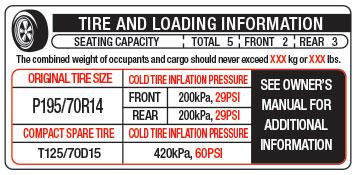
Tire Safety Ratings Lookup
To help you buy tires, NHTSA has rated thousands of tire lines, including most used on passenger cars, minivans, SUVs and light pickup trucks. The Uniform Tire Quality Grading System lets you compare tire treadwear, traction performance, and temperature resistance. See how your tires measure up.
Maintenance
Safety Tips
How well do you take care of your tires? Do you keep them properly inflated? Do you check to see if they're worn? How much do you know about basic tire maintenance and its impact on safety and fuel consumption? If you care about your safety, and about saving money, it's important to understand how tires affect your vehicle’s performance.
Stay safe by taking care of your tires
- Poor tire maintenance—not having enough air in your tires and failing to rotate your tires, among other maintenance requirements—can lead to a flat tire, blowout, or the tread coming off your tire.
- In 2023, a total of 646 people died on the road in tire-related crashes.
Save money by taking care of your tires
- Properly inflating your tires can save you as much as 11 cents per gallon on fuel. Yet only 19 percent of consumers properly inflate their tires. That means four out of five consumers are wasting money because of underinflated tires!
- Additional proper tire maintenance, such as rotation, balance and alignment, can help your tires last longer, which will in turn save you money. In fact, properly inflated tires can extend the average life of a tire by 4,700 miles.
Five tire maintenance tips for safety and savings
Proper tire pressure is the most important part of maintaining your tires. It affects safety, their durability, and your fuel consumption.
- Check the pressure of all tires, including your spare, at least once a month when the tires are "cold," meaning that the car hasn't been driven for at least three hours.
- Your tires' proper tire inflation pressure—measured in both kilopascals (kPA) and pounds per square inch (PSI or psi)—can be found on the Tire and Loading Information Label on the driver's side door edge or in your owner's manual. On new vehicles, the label will be located on the driver’s side doorjamb, called a “B-pillar.” If a vehicle does not have a B-pillar, then the label may be found on the rear-edge of the driver’s door. If the vehicle does not have a B-pillar, and if the driver’s door edge is too narrow, the label may be attached on an inward-facing surface next to the driver’s seating position.
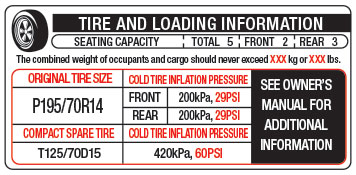
- Keep a tire pressure gauge in your vehicle. A tire can suddenly lose pressure if you drive over a pothole or bump into a curb when you park.
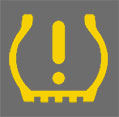 Newer vehicles have Tire Pressure Monitoring Systems, but these only activate a warning when a tire is significantly underinflated. You should still conduct a monthly tire pressure check to ensure your tires are always properly inflated.
Newer vehicles have Tire Pressure Monitoring Systems, but these only activate a warning when a tire is significantly underinflated. You should still conduct a monthly tire pressure check to ensure your tires are always properly inflated.
Tire tread provides the gripping action and traction that prevents your car or truck from slipping and sliding, especially when the road is icy or wet. Tires are not safe and should be replaced when the tread is worn down to 2/32 of an inch.
- Check your tire's tread at least once a month when you're checking their pressure.
- Tires have built-in "treadwear indicators," which are raised sections that run in between the tire's tread. When the tread is worn down so that it's level with the tread indicator, it's time to replace your tires.
- You can also check your tread by placing a penny in the tread with Lincoln's head upside down and facing you. If you can see the top of Lincoln's head, replace your tires.
Having your tires balanced and a wheel alignment performed by a qualified technician is important for the safety of your vehicle and to maximize the life of your tires.
- Tire balancing ensures your wheels rotate properly and don't cause the vehicle to shake or vibrate. New tires should always be balanced when installed.
- A wheel alignment maximizes the life of your tires and prevents your car from veering to the right or left when driving on a straight, level road.
- Rotating your tires can help reduce irregular wear, which will help your tires last longer and maintain the fuel efficiency of your tires.
- Check your owner's manual for information on how frequently the tires on your vehicle should be rotated and the best pattern for rotation.
- If recommended by the vehicle manufacturer, rotate tires every 5,000 to 8,000 miles or sooner if uneven wear appears.
- For some vehicles, tire rotation is not recommended. If your front and rear tires are different sizes, you may not be able to rotate your tires. Check your owner's manual for guidance.
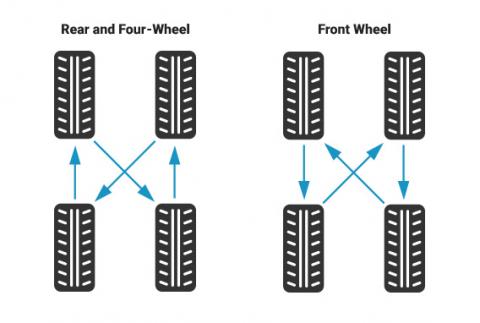
To maintain tire safety, purchase new tires that are the same size as the vehicle's original tires or another size recommended by the vehicle manufacturer. Check your owner's manual or the Tire and Loading Information Label located on the driver's side door edge or post to find the correct size for your car or truck. If you have any doubt about the correct size to choose, consult with the tire dealer. They can find the correct size tire for your vehicle.
Maintaining Proper Tire Pressure
Follow these tire pressure steps—they're the most important part of maintaining your tires:
- Step 1: Locate the recommended tire pressure on the Tire and Loading Information Labels on the driver's side door edge or post or in the owner's manual. (Remember, the correct pressure for your tire is what the vehicle manufacturer has listed, NOT what is listed on the tire itself.)
- Step 2: Check the tire pressure of all tires, including your spare tires.
- Step 3: If the tire pressure is too high in any of the tires, slowly release air by gently pressing on the tire valve stem with the edge of your tire gauge until you get to the correct pressure.
- Step 4: If the tire pressure is too low, note the difference between the measured tire pressure and the correct tire pressure. These "missing" pounds of pressure are what you will need to add. At a service station, add the missing pounds of air pressure to each tire that is under inflated.
- Step 5: Check all the tires to make sure they have the same air pressure (except in cases in which the front and rear tires are supposed to have different amounts of pressure).
Remember: The vehicle manufacturer's recommended tire inflation pressure is the proper psi (pounds per square inch) or kPa (kilopascals—the metric measure used internationally) when a tire is cold, meaning it has not been driven on for at least three hours. To get an accurate tire pressure reading, you must measure tire pressure when the tires are cold or compensate for the extra pressure in warm tires.
If you have been driving your vehicle and think a tire is underinflated, fill it to the recommended cold inflation pressure indicated on your vehicle's tire information placard or certification label. While your tire may still be slightly underinflated due to the extra pressure of a warm tire, it is safer to drive with air pressure that is slightly lower than the vehicle manufacturer's recommended cold inflation pressure than to drive with a significantly underinflated tire.
Since this is a temporary fix, don't forget to recheck and adjust the tire's pressure when you can obtain a cold reading.
Tire Blowouts
A tire blowout is a rapid loss of tire air pressure that can cause your vehicle to lose control. Although maintaining proper tire pressure can help you avoid blowouts, it’s not always possible. Here are some tips to help you stay safe in the event of a blowout.
What should I do if I have a tire blowout while driving?
The goal in any blowout is to keep the vehicle balanced and controllable. Do not panic. Any overreaction – including slamming on the brakes or abruptly removing your foot from the accelerator – can result in a loss of control over the vehicle. Instead, you should take the following steps:
- Hold the steering wheel with both hands.
- Maintain your vehicle speed if possible and if it’s safe to do so.
- Gradually release the accelerator.
- Correct the steering as necessary to stabilize your vehicle and regain control. Look where you want the vehicle to go and steer in that direction.
- Once your vehicle has stabilized, continue to slow down and pull off the road where and when you judge it’s safe to do so.
Is there a difference if my front tire blows out as opposed to my rear tire?
No matter which tire blows out—front or back—the steps for safely maintaining control of your vehicle are the same. The difference is in how you will feel it. In a front tire blowout, you will feel the force more in the vehicle’s steering. In a rear blowout, you will feel it more in the seat or body of the vehicle.
Tire Pressure Monitoring System (TPMS)
Tire pressure monitoring systems monitor the tire pressure through sensors located in the tires (direct system) or wheel speed use and other vehicle sensors (indirect system). The information collected by the sensors is transmitted to an on-board processor that interprets the sensor signals and warns the driver when tire pressure is below the acceptable level by illuminating the TPMS symbol on your dashboard.
All passenger cars, light trucks and vans that are model year 2008 or newer are required to come equipped with this feature. Some model year 2006 and 2007 vehicles are also equipped with TPMS. If you own a model year 2006 or 2007 vehicle, check with your dealer or your owner's manual to determine if it comes equipped with TPMS.
There are two different low tire pressure warning indicators allowed by the Federal standard. One icon is the cross-section of a tire with an exclamation mark inside. The other is a top view of a car with all four tires exposed. No matter which TPMS symbol your vehicle has, it will illuminate on the vehicle dashboard when your tire pressure is significantly under inflated.
When the TPMS symbol appears on your dashboard, it means at least one of your tires is significantly underinflated. You should inspect your tires and check the tire pressure as soon as possible. The symbol will extinguish after the tires are properly inflated.
On cold mornings, the TPMS symbol may illuminate for a short period of time and then turn off. This is likely caused by marginally low tire pressure that dips below the warning threshold overnight but rises to an acceptable level as the tires heat up through vehicle operation or an increase in external temperatures. If the TPMS symbol goes on and off, you should inspect your tires and check your tire pressure. The lamp should not illuminate when the tires are properly inflated.
All TPMS installed on 2008 model year vehicles and beyond are required to detect and warn the driver when the system is not functioning properly. A system malfunction may be indicated by a flashing of the TPMS symbol for 60 to 90 seconds with the warning lamp remaining illuminated after the flashing sequence. The flashing sequence followed by continuous illumination of the warning lamp will repeat at each subsequent vehicle start-up until the malfunction is corrected. You should contact your vehicle dealer for a system inspection.
Underinflated tires are visually difficult to detect. It is recommended that you inspect tires monthly with an accurate gauge. The TPMS is not intended to be a substitute for regular tire maintenance.
Aging
Most vehicle owners can easily overlook tire aging, increasing their risk of a crash. These Q&As will help you understand tire aging, how to extend the service life of your tires, and when to replace your tires.
Tire aging occurs when the rubber and other components in a tire change over time due to service, storage, and environmental conditions.
Most of us drive our vehicles enough that the tires’ treads wear out, and we replace our tires before aging becomes an issue. However, if you own or use recreational vehicles, 15-passenger vans, collector cars, any other vehicles you don’t drive regularly, or if your annual mileage is low, you could be at risk.
In addition to infrequent use, exposure to sunlight and warmer climate, poor storage and poor maintenance also contribute to tire aging. Tire aging is a greater concern in the more southern parts of the Sun Belt states.
You cannot detect tire aging simply by looking at your tires. However, there are steps you can take to extend the service life of your tires.
 Conduct monthly maintenance inspections, focusing on proper tire inflation pressure, treadwear and tire damage, along with recurring tire rotation, and balancing and alignment services.
Conduct monthly maintenance inspections, focusing on proper tire inflation pressure, treadwear and tire damage, along with recurring tire rotation, and balancing and alignment services.- If your car has a Tire Pressure Monitoring System (TPMS), pay attention to it! All passenger cars, light trucks, and vans that are model year 2008 or newer come equipped with this feature. If the TPMS symbol lights up on your dashboard, it means at least one tire is already significantly underinflated—you should take immediate action.
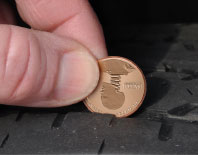 You should stop using tires for several reasons, including if a tire’s tread is worn down to a minimum depth using the penny test, signs of physical damage (cuts, cracks, bulges, etc.), or signs of irregular wear or other damage due to underinflation or overloading. Don’t use your spare as a replacement for worn tires.
You should stop using tires for several reasons, including if a tire’s tread is worn down to a minimum depth using the penny test, signs of physical damage (cuts, cracks, bulges, etc.), or signs of irregular wear or other damage due to underinflation or overloading. Don’t use your spare as a replacement for worn tires. - Consumers are strongly encouraged to be aware of not only their tires’ visual condition but also any change in how they perform. If you notice any tire performance issues, such as failing to maintain proper tire inflation pressure, noise, or vibration, consult a tire service professional.
- As tires age, they are more prone to failure. Some vehicle and tire manufacturers recommend replacing tires that are six to 10 years old, regardless of treadwear. You can determine how old your tire is by looking on the sidewall for your DOT Tire Identification Number (TIN) . The last four digits of the TIN indicate the week and year the tire was made. If the TIN reads 0308 it was made in the third week of 2008. Look on both sides of the tire. The TIN may not be on both sides.
Be aware of your spare
Spare tires on all vehicles are prone to aging because they seldom get replaced. Taking into account that tires degrade over time, NHTSA recommends that if your vehicle comes equipped with a full-size spare tire, that it not be used as a replacement for worn tires, except in emergencies such as replacing a flat tire.

If Tire Labels Could Talk, Here’s What They’d Say
There’s a ton of information on your tires that tells you about how they work with your vehicle to affect its performance. Understanding the tire labels for your passenger vehicle or light truck is important for maintaining and buying new tires. If labels could talk, here’s what they’d say:
Tires and Fuel Efficiency
In 2022, there were 283 million vehicles in the United States. Each year, vehicle owners purchase approximately 340 million replacement tires for vehicles, which consume about 135 billion gallons of gas annually. The tires you buy and how well you maintain them can significantly affect how much money you spend on fuel, as well as your vehicle's impact on the environment. Being an informed consumer and properly maintaining your tires means you can be green — and keep more "green" in your wallet.
Tire Design
The way tires are designed, such as materials, construction and tread design, influence tire performance and fuel efficiency. Also, a tire’s design can have other performance benefits, such as durability, wet and dry traction, handling, ride comfort and rolling resistance.
Rolling Resistance
Tires with low rolling resistance have characteristics that reduce energy loss, thereby improving fuel economy. It is estimated that a 10% reduction in tire rolling resistance will result in a 1-2% improvement in vehicle fuel economy. Original equipment manufacturers increasingly specify low-rolling-resistance tires for new vehicles. These tires commonly include attributes such as higher inflation pressure and reduced sidewall and tread deflection. When it comes time to replace your tires, low-rolling-resistance tires are also available from aftermarket tire vendors. Low-rolling-resistance replacement tires improve vehicle fuel economy, extend the range of electric and hybrid vehicles, and provide these additional expected benefits of:
- enhancing the fuel efficiency similar to the vehicles’ original equipment tires, and
- reducing fuel costs to consumers.
FuelEconomy.gov has more information on tire performance and fuel economy.
NHTSA is dedicated to promoting the safe use of vehicle equipment
Through safety standards and consumer information, NHTSA demonstrates its commitment to reducing tire-related crashes in the United States. We want to make sure you have the tools you need to avoid being in a tire-related crash. On our website, we provide information to consumers about buying tires, Uniform Tire Quality Grading System, also known as tire safety ratings, tire maintenance and labeling. Also, NHTSA issues and enforces federal safety standards for tires, rims, and tire pressure monitoring systems. We also provide resources for tire manufacturers, retailers, and other partners to provide essential information to consumers to help them choose and care for their tires.

